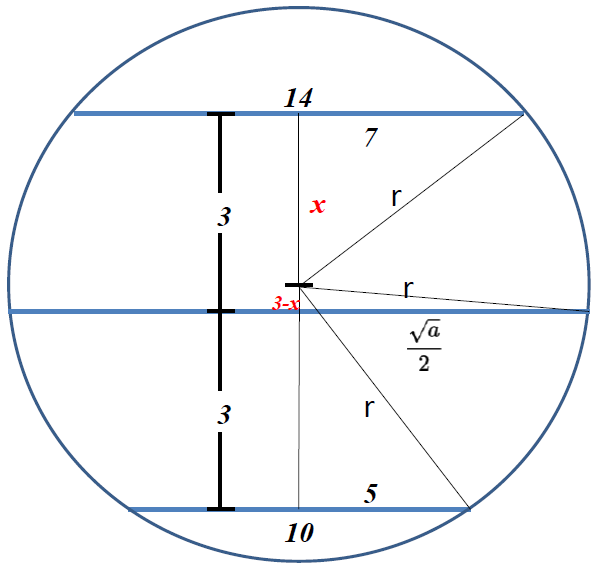two parallel chords in a circle have lengths 10 and 14, and the distance between them is 6.
The chord parallel to these chords and midway between them is of
length \(\sqrt{a}\). Find the value of a.

Phythagora's
\(\begin{array}{|lrcll|} \hline (1) & x^2+7^2 &=& r^2 \\ (2) & (3-x)^2 + \left(\dfrac{\sqrt{a}}{2}\right)^2 &=& r^2 \\ (3) & 5^2 + \Big(3+(3-x)\Big)^2 &=& r^2 \\ \hline \end{array} \)
\(\begin{array}{|lrcll|} \hline \mathbf{x=\ ?} \\ \hline (1)=(3): & r^2 = x^2+7^2 &=& 5^2 + \Big(3+(3-x)\Big)^2 \\ & x^2+7^2 &=& 5^2 + \Big(3+(3-x)\Big)^2 \\ & x^2+7^2 &=& 5^2 + (6-x)^2 \\ & x^2+7^2 &=& 5^2 + 6^2-12x+x^2 \\ & 7^2 &=& 5^2 + 6^2-12x \\ & 12x &=& 5^2 + 6^2 - 7^2 \\ & 12x &=& 12 \quad | \quad : 12 \\ & \mathbf{x}&=& \mathbf{1} \\ \hline \end{array}\)
\(\begin{array}{|lrcll|} \hline \mathbf{r^2=\ ?} \\ \hline (1): & r^2 &=& x^2+7^2 \quad | \quad \mathbf{x=1} \\ & r^2 &=& 1^2+7^2 \\ & \mathbf{r^2}&=& \mathbf{50} \\ \hline \end{array}\)
\(\begin{array}{|lrcll|} \hline \mathbf{a=\ ?} \\ \hline (2): & (3-x)^2 + \left(\dfrac{\sqrt{a}}{2}\right)^2 &=& r^2 \\ & (3-x)^2 + \dfrac{a}{4} &=& r^2 \quad | \quad \mathbf{x=1},\ \mathbf{r^2=50} \\ & (3-1)^2 + \dfrac{a}{4} &=& 50 \\ & 2^2 + \dfrac{a}{4} &=& 50 \\ & 4 + \dfrac{a}{4} &=& 50 \quad | \quad -4 \\ & \dfrac{a}{4} &=& 46 \quad | \quad * 4 \\ & \mathbf{a}&=& \mathbf{184} \\ \hline \end{array}\)
